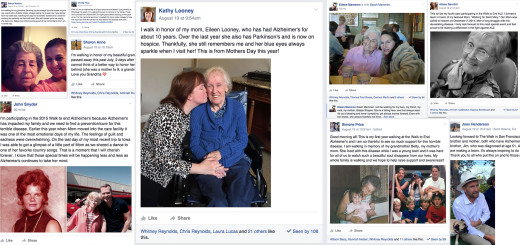Adding palliative care and hospice to your dementia plan
It’s hard to know what are the best care options to provide for your loved one, especially as they get closer to end of life. As your loved one’s advocate, it’s important that you know what options are available to you as your loved one transitions through the disease. Stefanie Bonigut, LCSW, Family Services Manager at the Alzheimer’s Association helps caregivers navigate these care options.

Understanding care options
A common question people ask, “The doctor just suggested hospice care for my mom – I don’t want to move her out of her home if she is going to die in a few days. What does all this mean?”
There are many misunderstandings about hospice care and a related program, palliative care. Both of these programs are tremendously helpful in dementia care and should be part of the dementia care plan.
Let’s now look at what the difference is between palliative care and hospice.
Palliative care
Palliative care is medical care for people living with a serious illness – it is available to people with dementia. It focuses on symptom and pain relief while also providing support for the best quality of life for the patient and the family. It can be provided along with disease treatment and be started at any stage in a serious illness.
Palliative care is a team-based approach to patient care. The palliative care team – doctors, nurses and other specialists – work together with the patient’s other doctors to support the patient and family.
Many palliative care programs have social workers to help with the emotional strain of a serious illness. It’s an extra layer of support that can help with overall communication, care coordination, advance care planning, and disease symptom management. Home healthcare services and equipment may also be available.
Accessing palliative care
Being able to access palliative care will depend on whether your health provider has the services. The care may be covered by Medicare or private health insurance plans. Ask your doctor if your health system has a palliative care program and request a consultation to see how the program will support you.

Starting palliative care early
While there may be periods of more rapid decline in a person’s cognition and functioning, most dementia progresses slowly over time. After an illness, traumatic event, or other acute decline, the person with dementia may plateau at a new, lower level of functioning. This makes determining how long a person with dementia will live especially difficult.
It also makes a strong case for the integration of palliative care into the dementia care plan. If palliative care is incorporated early into the care plan, the team can provide support around common symptoms such as depression in the person with dementia, management of dementia-related behaviors common in the middle stages of the disease, and effective pain control throughout the disease.
Palliative care can help lessen caregiver stress and help make sure that the person with dementia’s treatment decisions and end of life wishes are followed. When palliative care is part of the care plan, it can also be easily converted into the comfort care of hospice toward the end of the patient’s life and the bereavement support for families after the person with dementia’s death.

Hospice
Hospice care becomes available when the patient’s disease has progressed to where it is life-limiting. This generally happens when the efforts to cure the disease are no longer working or when the patient decides the burdens of treatment outweigh the benefits. Life-limiting means that the doctor thinks the patient has less than six months to live when attempts to treat or cure the disease are stopped.
Many diseases have treatment options but, because dementia has no treatment, only symptom management, families are often unsure when to access hospice. In order to be eligible for Medicare provided hospice, patients must meet specific criteria to indicate that they are in the end stages of dementia.
While this is not a complete list, here are some indicators that your loved one may be ready for hospice:
- Inability to walk or move about
- Inability to perform personal grooming without assistance
- Incontinence
- Weight loss
- Limited ability to communicate verbally
- The existence of other secondary medical conditions
The goal of hospice is to provide comfort care – pain management and symptom control – to ease pain and suffering and maximize quality of life. As with palliative care, hospice is provided by a team including doctors, nurses, home aides, social workers, and bereavement experts. Often trained volunteers are involved providing additional patient support.
Spiritual support may be offered through chaplain services. Hospice also provides emotional and bereavement support to the patient’s family. Patients and families usually have 24/7 access to at least one member of the hospice team.
Hospice doesn’t mean death is days away although, as you might imagine, doctors may have a hard time predicting how long the patient will live. Because of this, hospice care can be recertified if a patient lives longer than six months. A patient can also discontinue hospice care and have services restarted as long as the doctor still believes the patient has less than six months to live.
In home hospice
A patient doesn’t have to move to receive hospice services. Hospice can be provided in hospital, in long-term or residential care settings, in a dedicated hospice center, or in your own home.

Increased use of hospice
Utilization of hospice for people with dementia has increased in the past decade. According to the 2020 Alzheimer’s Disease Facts and Figures Report, dementia is the second most common primary diagnosis for Medicare beneficiaries admitted to hospice overall. In 2017, California had more than 30,000 people (20%) admitted to hospice with a primary diagnosis of dementia. In Nevada there were more than 2,000 (17%) admitted.
Research has also shown that using hospice services results in better pain management and reduced rates of hospitalization for the person with dementia. It has also shown reduced caregiver stress and burden, as well as higher family satisfaction with care.
Paying for hospice
Medicare is the primary source of payment for hospice care, but private insurance, Medicaid and other sources also pay for hospice care. Based on data from the National Hospice Survey, in the 2020 Facts and Figures Report, for 2008 to 2011, nearly all (99%) hospice organizations cared for individuals with dementia.
There are many palliative and hospice care providers that can help support you. Call our 24/7 Helpline at 800.272.3900 to find one in your area. The National Hospice and Palliative Care Organization’s website is a wealth of information on these services.
For more information about hospice care for dementia visit our website.
Learn more:
- The Hospice Foundation of America has information on how to locate a hospice, questions to ask when selecting a hospice, and resources related to hospice care and grief.
- The National Hospice Foundation website offers guidance in finding and selecting a hospice program.
- The National Hospice and Palliative Care Organization has a variety of free resources on topics including advance care planning, hospice and palliative care, and grief and loss.
- To locate a hospice provider, use our Community Resource Finder.
- Information on Facts and Figures visit alz.org/facts

















